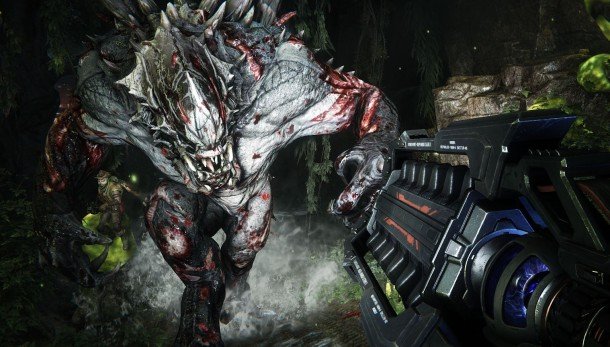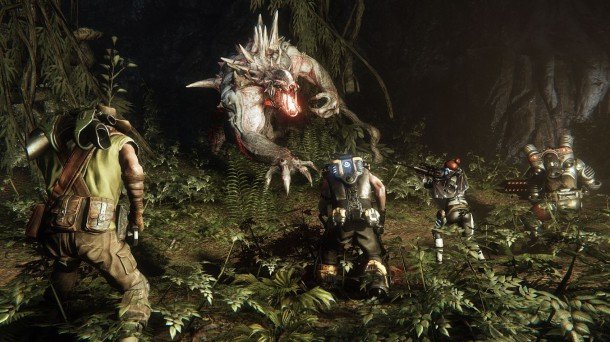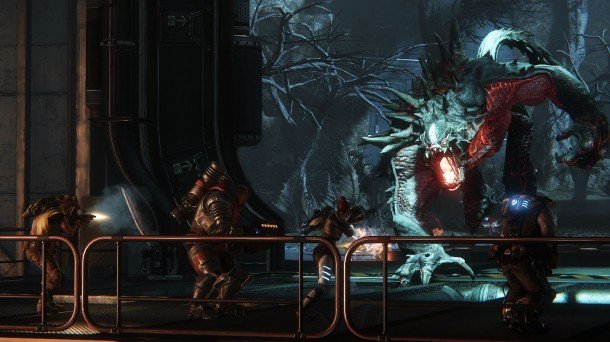
By Ben Griffin.
Picture Left 4 Dead on Avatar's world of Pandora. Picture hordes of exotic wildlife, some friendly and some not so. Picture Bill, Zoey, Louis and Francis replaced by four interplanetary Hunters charged with protecting human colonies in deep space. And picture a 30ft-tall beast gunning for them. Picture that, and you've gone some way to picturing Evolve, the new four-on-one sci-fi shooter from Left 4 Dead makers Turtle Rock.
Founded in 2002, the developers made their name with the Valve-owned Counter-Strike: Condition Zero, and later Counter- Strike: Source. Then after a prod by Valve to design their own property, the Counter-Strike custodians replied with arguably the best zombie game ever. That was six years ago.
“We wanted to do something big before people forgot that we were the Left 4 Dead developers,” says Turtle Rock's executive producer Matt O'Driscoll. “We learned a lot from that game in terms of multiplayer and co-op. Evolve carries the Left 4 Dead DNA.”
In Evolve, up to five players face off in class-based combat. Four of them band together as Hunters, while the last plays the monster, which will be different on each map. On Forest Ruin it's the Goliath – the angry dad of the Star Wars Rancor with armoured skin and fire breath. O'Driscoll likens each 20-minute match to an epic boss battle. Unlike most scripted encounters, where you aim for a glowing weak spot and dodge a flurry of forecasted attackers, fights here are organic. They 'evolve'.

“We learnt that people like playing cooperatively,” says Phil Robb, founder and art director at Turtle Rock. “We're always looking for experiences we want that nobody has given us. That's where a lot of our game ideas come from. As far as what we brought over, it's a lot of small things.” Incapacitations, for example: “People don't just want to die. We want to give them a chance to come back.”
A lot carries over, but much has also been left behind – Valve, for example. “Certainly Valve had a big part in the initial days of Turtle Rock,” Robb says. “We worked very closely with them, we learned a lot from working with them. But some of their things are a little different from the way we want to do things. We have often been asked this question: 'You did Left 4 Dead, but how much did you really do?' We're not going to sit here and say a bunch of words and expect you to take our word for it. We're going to make a kickass game. We'll do our best to prove that Turtle Rock is the real deal, and we don't necessarily need Valve to be great... as much as we respect and love them.”
Keep up to date with the most important stories and the best deals, as picked by the PC Gamer team.
Turtle Rock want to establish their own identity, and the way to do that is Shear. A topographically scattershot ball of rock spinning on the end of the Milky Way's longest arm, Shear is Earth if humanity languished in the middle of the food chain. We've broken from the bounds of the Solar System and spread out across the galaxy. There are colonies everywhere, and the farther you get from Earth, the more inhospitable they become. There is no planet farther than Shear. It's one big frontier town, and people are settling there – or trying – for the same reason that they settled in the American West. Money. Opportunity. A new life.
“Early on, we tried some experiments with making the planet super weird, but at some point you take that too far and people become uncomfortable,” Robb says. “You want to create a world where people understand the rules... so you draw heavy inspiration from Earth environments.” That's the ice, desert and lava levels confirmed, then.

“I think you see that in pretty much every science fiction movie ever,” he adds. “Star Wars certainly did that with Hoth and [Tatooine]. Avatar did it too. You'll think that you're in a jungle on Earth, but then something pops out and you're like, 'Oh, that's new.'”
That's where our Hunters come in. They're planet tamers – think Liam Neeson in The Grey armed with armour-piercing bullets rather than poems. They drop down from ships and safeguard colonies from sharp-toothed natives. “The thing is,” Robb says, “these guys are used to dealing with a certain level of wildlife, but they get here and the monsters are a bit above what they're used to. So they find themselves in a tricky situation. These things are intelligent and they've got some mysterious unknown agenda that we don't understand.”
Pitting differently-powered players against each other recalls Left 4 Dead's Infected mode. The main difference here being that, rather than monsters hunting humans, for the most part humans hunt monsters. So what's to stop the bigger and faster Goliath simply legging it?
On the mode I played, Hunt, the Goliath must meet its own objective to win: here it is destroy the generators. Thing is, he starts as something small and squishy – no match for a team of heavily armed Hunters. So his aim is to roam the map killing and eating its fauna in order to bulk up. The first of many different types and builds of boss, Goliath is a King Kong type who can scramble up vertical surfaces and leap like Ang Lee's Hulk. In terms of handling he reminds me of Left 4 Dead's Tank – Goliath can charge, wrench and throw rocks from the ground, and flail around with his slab of a forearm.
PC Gamer is the global authority on PC games—starting in 1993 with the magazine, and then in 2010 with this website you're currently reading. We have writers across the US, Canada, UK and Australia, who you can read about here.


